Maximizing recovery time between knock-out races improves sprint cross-country skiing performance
Kerry McGawley*,Coline Van Waerbeke,Karl-Johan Westberg,Erik P.Andersson
Swedish Winter Sports Research Centre,Department of Health Sciences,Mid Sweden University, €Ostersund 831 25,Sweden
Abstract
Keywords: Energetics;Repeated sprints;Roller skiing;Simulated competition;Tactics
1. Introduction
The sprint discipline in cross-country (XC) skiing was introduced to the International Ski Federation (FIS) World Championships for both men and women in 2001. For the 6 most successful skiers, a sprint competition involves 4 consecutive high-intensity races performed on the same course within a timeframe of »3-4 h, with each race lasting»3 min.1,2Athletes first complete an individual time trial (a prologue(P));then the 30 skiers with the fastest recorded times progress to the quarter-finals (QF).3Unlike the P, the QF,semi-finals (SF), and final (F) are organized as head-to-head knock-out heats involving 6 skiers each. The 2 fastest skiers from each of the QF and SF heats qualify for the subsequent round, and 2 additional lucky-loser spots are given to the 2 next fastest skiers(Fig.1).
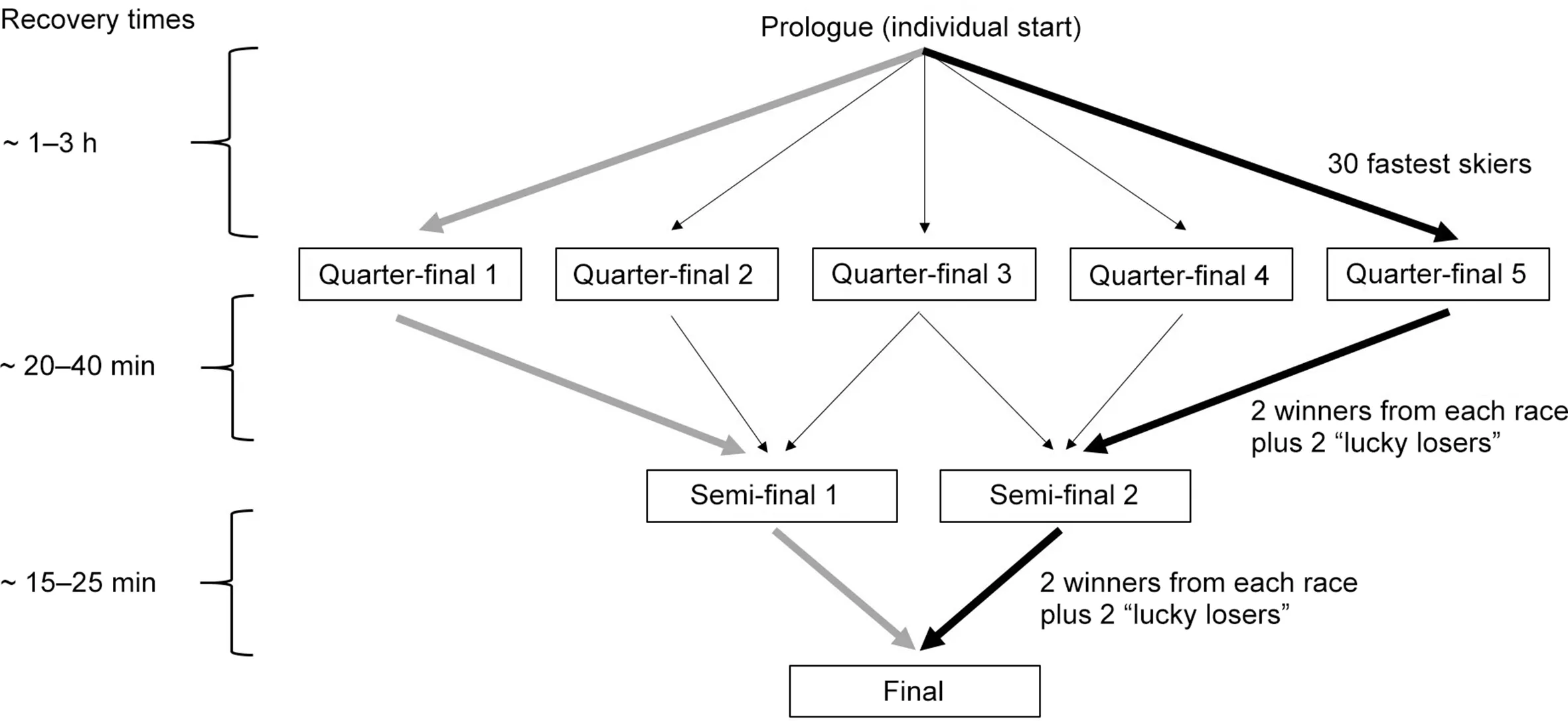
Fig.1. A schematic outlining the procedures during a sprint cross-country skiing competition.The route with maximum recovery time between the quarter-final and the final is denoted by heavy gray arrows;the route with minimum recovery time between these heats is denoted by heavy black arrows.TagedEnd
The recovery durations between rounds in a sprint XC ski competition are irregular,2,4typically ranging from»15-40 min in the knock-out stages. This duration is shorter than that for several other sports where athletes complete multiple races on the same day, such as swimming or track cycling. Previous research using a mathematical simulation has predicted that at least 20 min are required after an initial sprint race to ensure that XC ski performance in a subsequent race is not negatively influenced by fatigue from the initial race(e.g.,due to incomplete recovery of anaerobic energy systems and/or elevated blood lactate(BLa)concentrations.5This is consistent with the findings of Vesterinen et al.,6who observed no accumulation of fatigue(i.e.,no changes in skiing speed,peak oxygen uptake, peak heart rate, or peak BLa concentration) when 16 highly trained male XC skiers were prescribed 20 min of recovery between 4£850 m roller-ski races on a tartan track. However, Zory et al.7reported significant fatigue (i.e., changes in skiing speed, BLa concentration, and mechanical force and power output) in 7 elite male XC skiers when only 12 min of recovery were prescribed between 3£1200 m races. In competition settings, the recovery time separating the first SF heat and the F might be >20 min, and that between the second SF heat and the F might be<20 min.Despite this difference,which could significantly affect performance during the F, no study has investigated the effects of XC skiers’ taking different routes through the knock-out rounds and using recovery durations that are typical of realworld competition scenarios.
A new rule introduced by FIS in 2014 has led to a unique tactical component to sprint XC ski competitions, with athletes able to self-select their QF heat according to their ranking after the P. Specifically, athletes ranked 11th through 1st are first to select their QF heat, followed by athletes ranked 12th through 30th.8This format aims to benefit the highest-ranked skiers,who are able to make a strategic choice regarding not only the QF heat in which they wish to compete but also whom they compete against.As shown in Fig.1,racing in the first QF heat would allow more recovery time before the SF and F, whereas racing in the last QF heat would lead to shorter recovery periods between subsequent races.Consequently,the opposition may be comparatively weaker in the later QF heats.To date,no experimental data concerning the relative effects of longer vs.shorter recovery periods in XC skiing are available.
The scientific aim of the current study was to examine the performance and the physiological and perceived effects of longer vs.shorter recovery periods between the QF,SF,and F during a laboratory-based, simulated sprint XC ski competition. The practical objective was to generate data that could help to inform decision making when XC skiers are faced with selecting a QF heat under competition conditions. Longer recovery periods between sprint races were expected to lead to more complete recovery and,as a result,superior performance during the F.
2. Methods
2.1. Participants
Nine male and 2 female XC ski athletes volunteered to participate in the study(age=24.0§ 3.5 years; height=181.8§7.2 cm, body mass=76.5 § 7.4 kg; mean § SD). All participants were required to be competing nationally or internationally and had experience of treadmill roller-skiing and the test protocols as a result of regular laboratory training and testing sessions. Four of the participants were competing internationally in World Cup races and were members of the national development team, whereas the remaining 7 participants were competing at a high level nationally.All participants had completed at least 4 years of structured training and racing. The participants were fully informed of the nature of the study before providing written consent to participate.The study was approved by the Regional Ethical Review Board of Umea-University, Sweden (#2016-443-31M) and was conducted in accordance with the Declaration of Helsinki.
2.2. Study overview
Participants completed a preliminary trial and 2 main experimental trials on 3 separate days. There was a minimum of 24 h separating the preliminary trial and the first main trial,whereas the 2 main trials were separated by 2-4 days. All exercise tests were performed at a fixed 4˚incline using treadmill roller-skiing and the gear 3 ski-skating sub-technique,which involves 1 poling action for each leg stroke.9The preliminary trial required participants to perform a submaximal incremental test followed by 2 maximal, self-paced, 883 m sprint time trials(STTs).The fastest of these 2 STTs was used to determine a fixed speed (corresponding to 95.6% of each individual’s maximal effort,calculated as the distance divided by 1.046£STT time) for the first 3 races completed during the 2 subsequent main trials (fixed-speed prologue (PFIX),fixed-speed quarter-final (QFFIX), and fixed-speed semi-final(SFFIX).The fourth race during the main trials was completed as a time trial to determine performance(final sprint time trial(FSTT)).The 2 main trials differed in the durations of the recovery periods prescribed between the QFFIX,SFFIX,and FSTT(Fig.2).In 1 condition,maximum recovery periods(MAX-REC)were prescribed to simulate a competition situation in which athletes complete the first QF and SF heats.In the other condition,minimum recovery periods (MIN-REC) were prescribed to simulate a competition situation where athletes complete the last QF and SF heats.Participants were blinded to the condition and their results,receiving no time or performance feedback until after the completion of the experiment.The 2 conditions were completed in a semi-randomized,counterbalanced order,with 5 participants(1 woman)completing MAX-REC first and 6 participants(1 woman)completing MIN-REC first.Participants were instructed to abstain from alcohol for at least 24 h prior to testing and from caffeine on the test day prior to testing.They were instructed either to rest or to perform a maximum of 90 min of low-intensity training the day before testing.
2.3. Equipment
All tests were performed on a motor-driven treadmill designed for roller skiing(Rodby Innovation AB,V€ange,Sweden). For safety reasons, participants wore a safety harness around the waist that was suspended from the ceiling and connected to an emergency brake. Self-pacing during the STTs was possible via 2 laser beams,which detected the position of the skier on the treadmill.The speed of the treadmill automatically increased(by 0.5 km/h/s)or decreased(by 0.4 km/h/s)if the skier moved to the front or rear of the belt, respectively,and maintained a constant speed otherwise. The self-pacing system was disabled during PFIX, QFFIX, and SFFIX. Participants used their own ski boots and poles,which were equipped with carbide tips designed for treadmill roller skiing.The roller skis (Pro-Ski C2; Sterner Specialfabrik AB, Dala-J€arna, Sweden) were fitted with either NNN (Rottefella, Klockarstua,Norway)or SNS(Salomon,Annecy,France)binding systems.The rolling resistance coefficient of both pairs of roller skis was 0.023, which was determined as previously described.10Before testing,roller skis were prewarmed in a heating box for at least 60 min to prevent a warming-up effect of the wheels and bearings during testing.
Body and equipment masses were measured prior to each test using a standing scale(Seca 764;SECA GmbH Co.KG,Hamburg,Germany). Respiratory variables were measured breath-by-breath using a MetaMax 3B-R2 portable metabolic system (Cortex Biophysik, Leipzig, Germany) and were interpolated to provide second-by-second data. Before each measurement, ambient conditions were monitored, gas analyzers were calibrated using a mixture of 15%O2and 5%CO2,and calibration of the flow transducer was performed with a 3-L air syringe.Heart rate(HR)was measured using a chest strap and wristwatch (Polar Electro Oy,Kempele, Finland). BLa concentration was measured from a fingertip blood sample and analyzed using a Biosen C-line (EKF diagnostic, Magdeburg, Germany), which was calibrated with a standard lactate solution with a concentration of 12 mmol/L prior to each analysis.
2.4. Testing procedures
2.4.1. Preliminary trial(test Day 1)
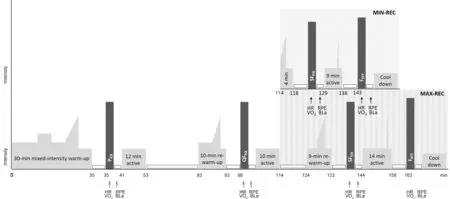
Fig.2. A schematic of the protocol used during the 2 main experimental trials,with light-gray areas denoting warm-up and active recovery,white areas denoting passive rest, and dark-gray areas denoting the sprint bouts. Measurements are marked by vertical arrows. BLa=blood lactate; FSTT=final sprint time trial;HR=heart rate;MAX-REC=maximum recovery periods; MIN-REC=minimum recovery periods;PFIX=fixed-intensity prologue;QFFIX=fixed-intensity quarter-final;RPE=rating of perceived exertion;SFFIX=fixed-intensity semi-final;VO2=oxygen uptake.
Participants completed a submaximal exercise protocol consisting of 4-7£5-min incremental stages, depending on the ability and fitness level of the individual.Treadmill incline was fixed at 4˚, and the protocol commenced at 7.2 km/h for the women and 10.2 km/h for the men. Speed then increased every 5 min by 0.6 km/h and 0.8 km/h for the women and men, respectively. Respiratory variables were monitored continuously and were averaged over the final minute of each stage. At the end of each stage, a rating of perceived exertion(RPE) was recorded, and the submaximal test was terminated at an RPE of 15-16 and/or when the respiratory exchange ratio (RER) approached 1.00. After the submaximal test, participants completed a 10-min cool-down at a slow, self-paced speed,after which they performed 2 STTs at a 4˚incline.The STTs were separated by 25 min of rest,which included 20 min of active recovery at a slow, self-paced speed. Participants were verbally encouraged to complete the STTs as fast as possible. They could see the distance completed on a screen in front of them,but speed and elapsed time were concealed.
2.4.2. Experimental trials(test Days 2 and 3)
During the 2 main trials,participants completed a simulated sprint XC ski competition including 4 races(Fig.2)performed using treadmill roller skiing. In MAX-REC, the time between the end of the second race (QFFIX) and the start of the third race (SFFIX) was 37 min, whereas in MIN-REC this duration was 22 min.Between the end of SFFIXand the start of the final race (FSTT), the duration was 22 min in MAX-REC and 17 min in MIN-REC.Before commencing the first race(PFIX),participants completed a standardized 30-min warm-up at a 4˚ incline, including (for women and men, respectively) 10 min at 7.2 km/h or 9.0 km/h, 5 min at 10.0 km/h or 12.5 km/h,5 min at 7.2 km/h or 9.0 km/h,and 5 intermittent-intensity pyramids at 8.0-14.0 km/h or 10.0-18.0 km/h. This was followed by an easier 5-min bout at 2˚and 6.4 km/h or 8.0 km/h.After PFIX, participants had 60 min of recovery during both main trials(3 min of passive recovery,12 min of active recovery, 30 min of passive recovery, a 10-min mixed-intensity rewarm-up,and 5 min of passive rest while re-setting up)before completing QFFIX. After recovery from QFFIX(3 min passive and 10 min active),the recovery periods differed in the 2 main trials as shown in Fig.2.Respiratory data and HR were monitored continuously during the races. The highest 20-s rolling average during each race was used to calculate peak oxygen uptake (peak _VO2),peak ventilation rate (peak _VE), and peak RER,whereas peak HR was recorded as the highest 1-s value.Immediately after each race, an RPE score was recorded for breathing,arms,and legs.Fingertip blood samples were taken 2 min before and 2 min after each sprint race for the subsequent analysis of BLa concentration.
The speed of the treadmill was constant for the first 3 races(PFIX, QFFIX, and SFFIX) and corresponded to 95.6% of the average speed during the fastest STT from the preliminary trial. The FSTTwas then performed at a self-selected pace in order to measure performance.The distance completed during the FSTTwas automatically logged every 0.406 s (2.46 Hz),and time points for all 0.25-m segments along the 883-m course were calculated by using linear interpolation, with instantaneous speed calculated for each 0.25-m segment.
2.5. Calculations
The power output for the submaximal stages during the preliminary trial and for the 4 races during the experimental trials was calculated as the total power exerted to overcome rolling resistance and to elevate body mass and skiing equipment(msys)against gravity:

where g is gravitational acceleration, v is the treadmill speed(m/s), mRis the rolling resistance coefficient, and a is the treadmill incline. Energy expenditure was calculated from_VO2(L/min)and RER(_VCO2/_VO2)using the Weir11equation and was expressed as a metabolic rate.The metabolic rate was based on the average _VO2and RER values(-1.00)during the final minute of each stage of the submaximal exercise protocol.During the experimental trials,aerobic metabolic rate was calculated using the same equation but assuming 100% carbohydrate utilization(i.e.,using an RER of 1.00):

Gross efficiency (GE) was calculated as the ratio between power output and metabolic rate for each submaximal stage during the preliminary trial. The average GE for the 3 final submaximal stages was used to determine the anaerobic contribution during the 4 races within the experimental trials. This procedure was chosen because GE was observed to be independent of speed, which has been shown previously for other XC skiing sub-techniques,12,13unlike cycle ergometry, where GE increases with submaximal exercise intensity.14
Respiratory variables assessed during the 4 races were used to determine the aerobic and anaerobic metabolic rates for the experimental trials, with second-by-second respiratory data being interpolated over the 0.25-m time-points throughout the 883-m course. The required instantaneous total metabolic rate(W) during the races was calculated as the instantaneous power output divided by the predetermined GE. The instantaneous anaerobic metabolic rate (W) could then be calculated as the difference between the required instantaneous total metabolic rate and the instantaneous aerobic metabolic rate,with aerobic metabolic rate calculated according to Eq. (2) but using a fixed RER value of 1.00(i.e.,assuming 100%carbohydrate utilization). The average anaerobic metabolic rate for each race was calculated as the instantaneous anaerobic metabolic rate(W)integrated over all the 0.25-m time points and divided by the total time, with the same calculation used for calculating the average aerobic metabolic rate. The same approach was employed for calculating the average anaerobic and aerobic metabolic rates during the 4 quartiles of the course (i.e., for each of the 4£220.75-m course segments).The anaerobic energy supply was calculated as the average anaerobic metabolic rate multiplied by race time in seconds. The anaerobic energy supply was also expressed as an oxygen deficit by using an oxygen equivalent of 0.047801 mL/J (assuming 100% carbohydrate utilization).11Power output and metabolic rates were expressed relative to the skiers’system mass(SM=body mass+equipment mass),which was measured prior to each trial(80.9§7.5 kg).Equipment mass(i.e., the combined mass of the ski boots, roller skis, and ski poles)was 4.4§0.4 kg.
2.6. Statistical analyses
The SPSS (Version 27; IBM Corp., Armonk, NY, USA)was used for the statistical analyses.Two-way repeated measures analysis of variance(ANOVA)tests with 2 within-participant factors were used to compare differences between the first 3 fixed-speed races(PFIX,QFFIX,and SFFIX)and recovery condition(MAX-REC vs.MIN-REC),as well as the associated interaction effects. For RPE, the main effect of race was analyzed using a Friedman test (comparing median values based on MAX-REC and MIN-REC), and the main effect of recovery condition was analyzed using a Wilcoxon signed-rank test(comparing median values based on the 3 races). Two-way repeated-measures ANOVA tests were also used to compare differences between the 4 quartiles during the FSTTfor the 2 trials (MAX-REC vs. MIN-REC). Sphericity was checked using the Mauchly test, and where this assumption was violated,as was the case when analyzing the 4 quartiles,a Greenhouse-Geisser correction was applied(due to epsilon estimates below 0.75). Bonferroni a corrections were applied to all ANOVA tests. Paired t tests were used to compare responses to the FSTTduring MAX-REC and MIN-REC (or Wilcoxon signed-rank tests for RPE). Corrected Hedges’ g effect sizes(ES) were calculated for the pairwise comparisons according to the equation provided by Lakens15and are interpreted as small: -0.2-<0.5, medium: -0.5-<0.8, or large: -0.8.16Data are reported as mean § SD (or median (range) for RPE)and the level of significance was set at p<0.05.
3. Results
3.1. Preliminary trial
The average GE for the 3 final submaximal stages was 18.5%§1.0%,which was similar to the GE for the final submaximal stage(e.g.,18.6%§1.0%).The best of the 2 preliminary STTs was completed in 183.2§16.5 s(17.5§1.5 km/h),which was achieved during the first effort for 8 participants and during the second effort for the remaining 3 participants.The typical error for the time to complete the 2 STTs was 3.5 s(or 1.9%when expressed relative to the grand mean).
3.2. Experimental trials
3.2.1. Fixed speed races(PFIX,QFFIX,and SFFIX)
The first 3 sprint races(PFIX,QFFIX,and SFFIX)were completed at a fixed speed of 16.7§ 1.3 km/h during both MAXREC and MIN-REC, resulting in a standardized race time of 191.6 § 16.7 s and a power output of 4.29 § 0.35 W/kg SM.Physiological and perceptual responses to the PFIX,QFFIX,and SFFIXare presented in Fig. 3. No main effects for recovery condition(i.e.,MAX-REC vs.MIN-REC)reached significance(p > 0.05). However, there were significant main effects for race for a number of the variables (e.g., Fig. 3H, 3J, 3K, 3L,3N,and 3O;p<0.05).There were also significant interaction effects(i.e.,recovery condition£race)for average _VO2,oxygen deficit, anaerobic energy supply, aerobic MR, anaerobic MR,and anaerobic contribution(p<0.05;Fig.3A-3F).
3.2.2. Time trial(FSTT)
The FSTTwas completed 5.4 § 5.5 s faster during MAXREC compared to MIN-REC (179.2 § 18.1 s vs. 184.6 §20.0 s,respectively;p=0.009,ES=0.26)(Fig.4A).Total metabolic rate was higher during MAX-REC compared to MINREC (24.9 § 2.3 W/kg SM vs. 24.3 § 2.4 W/kg SM, respectively; p=0.009, ES=0.27) (Fig. 4B). However, differences in aerobic and anaerobic metabolic rates for MAX-REC vs.MIN-REC did not reach significance due to individual variation in these variables (p > 0.05) (Fig. 4C and 4D). All other performance, physiological, and perceptual responses to the FSTTraces during MAX-REC and MIN-REC are presented in Table 1.During MAX-REC,speed(and,therefore,power output) was higher (p=0.008), pre-FSTTBLa concentration was lower (p=0.027), and pre-to-post FSTT(i.e., delta) BLa concentration was higher (p=0.024) compared to MIN-REC.No other differences between the 2 recovery conditions reached statistical significance(p>0.05).
The power output and the aerobic and anaerobic metabolic rates during the 4 quartiles of the 2 FSTTraces are illustrated in Fig.5.Significant main effects of time(i.e.,changes over the 4 quartiles)were observed for power output and the aerobic and anaerobic metabolic rates, whereas none of the interaction effects reached significance(p>0.05).
4. Discussion
The aim of the current study was to examine the performance and the physiological and perceived effects of longer vs.shorter recovery periods between the QF, SF, and F during a laboratory-based, simulated sprint XC ski competition. As expected,longer recovery periods between sprint races led to superior performance during the FSTT. This improvement in performance was linked to significant alterations in power output, total metabolic rate and BLa concentrations during MAX-REC compared to MIN-REC. However, at least partly due to individual variation in the physiological and perceptual responses to the 2 experimental conditions (e.g., Fig. 4A-4D), no other differences between MAX-REC and MIN-REC reached statistical significance.
Sprint XC ski competitions are characterized by short recovery durations (»15-40 min between the 3 knock-out rounds) separating a series of relatively short (»3 min) races.The recovery bouts between the repeated sprints involve a mixture of passive and active recovery,6,7,17which was duplicated in the current study. The exercise intensities during the races are typically very high, with considerable anaerobic energy contributions and mean _VO2values close to_VO2max.1,4,18,19A unique component that differentiates sprint XC skiing from other sporting events is the choice faced by competing athletes regarding which QF heat they will selfselect, a process that rewards those who qualify with a faster time in the P.Despite the existence of this tactical component,the extent to which different pathways through a sprint competition affects performance has not previously been investigated under controlled experimental conditions.The current findings showed a mean improvement in final sprint(i.e.,FSTT)time of 5.4 s when longer recovery durations were prescribed between races (i.e., MAX-REC) vs. shorter recovery durations (MINREC). This was equivalent to a 2.8% improvement in performance, with all participants improving their FSTTtime by 0%-9%in MAX-REC compared to MIN-REC.These findings suggest that selecting the first QF heat would be significantly more favorable than selecting the last QF heat in realworld competition settings.
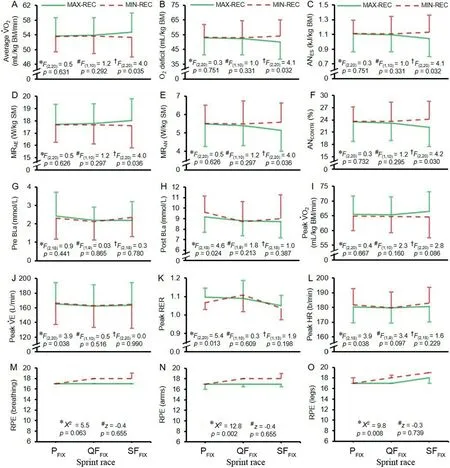
Fig.3. Physiological responses(mean§SD)and median(interquartile range)perceived responses(RPE)during the first 3 fixed-speed sprint races(PFIX,QFFIX,and SFFIX) for the trials with longer (MAX-REC) vs. shorter (MIN-REC) recovery periods between QFFIX and SFFIX. Each separate panel is distinguished by a label from A through O.F and p statistics are presented for:*main effect of race(i.e.,PFIX,QFFIX,SFFIX); #main effect of condition(i.e.,MAX-REC,MIN-REC);ymain interaction effect(i.e.,race£condition).Nonparametric alternatives were used for RPE.n=10 for peak HR and post BLa.ANCONTR=anaerobic contribution; ANES=anaerobic energy supply; BM=body mass; HR=heart rate; MAX-REC=maximum recovery periods; MIN-REC=minimum recovery periods;MRAE=aerobic metabolic rate;MRAN=anaerobic metabolic rate;O2=oxygen;PFIX=fixed-intensity prologue;Post BLa=blood lactate concentration measured 2-min after the sprint race;Pre BLa=blood lactate concentration measured 2-min prior to the sprint race;QFFIX=fixed-intensity quarter-final;RER=respiratory exchange ratio; RPE=rating of perceived exertion (Borg 6-20); SFFIX=fixed-intensity semi-final; SM=system mass; _VE=ventilation rate; _VO2=oxygen uptake.
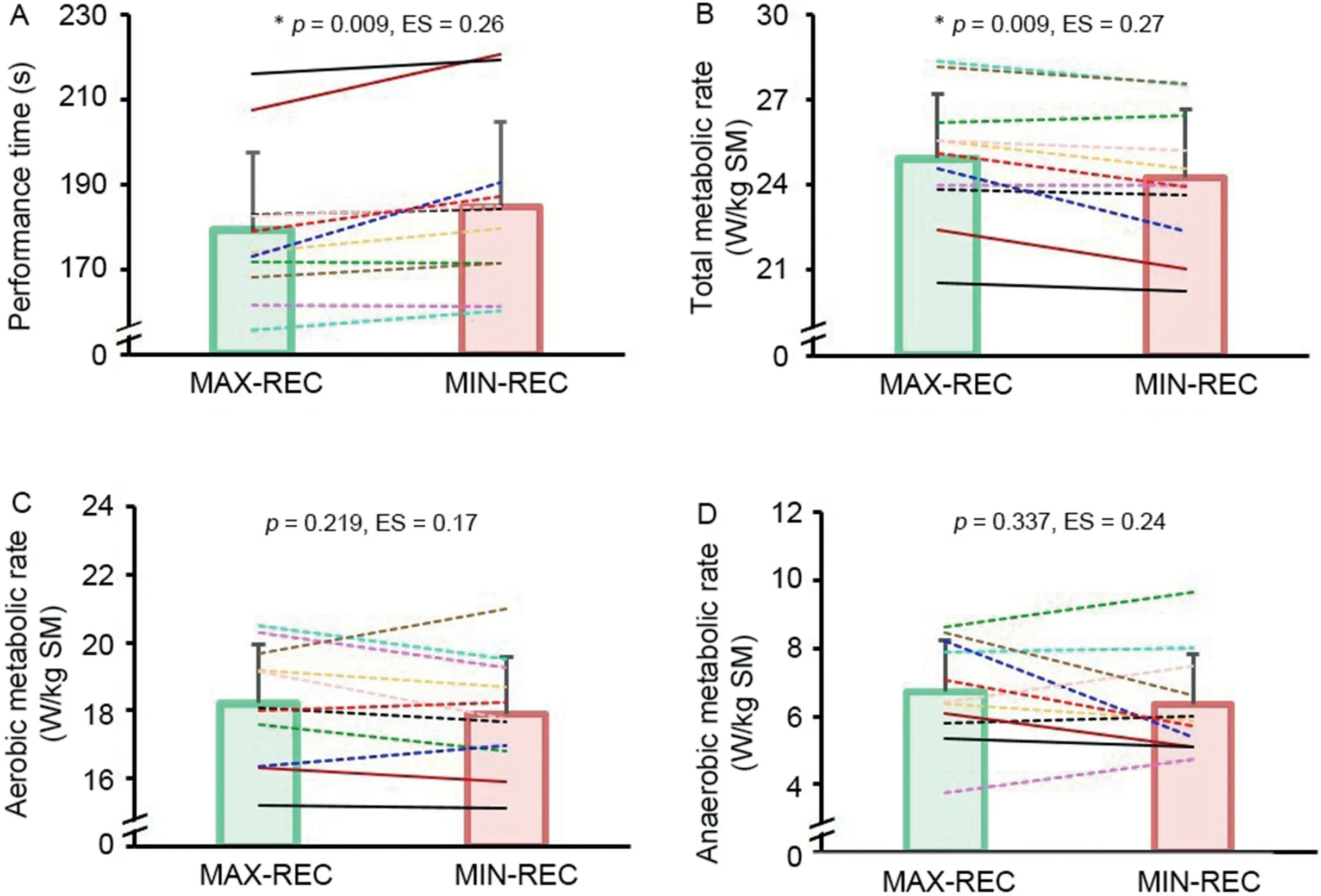
Fig.4. (A)Performance time,(B)total metabolic rate,(C)aerobic metabolic rate,and(D)anaerobic metabolic rate during the FSTT after longer(MAX-REC)vs.shorter(MIN-REC)recovery periods(mean§SD).Individual performances are marked as dashed(men)and hard(women)lines.*Significant difference between conditions (p=0.009). ES=effect size (corrected Hedges’ g); MAX-REC=maximum recovery periods; MIN-REC=minimum recovery periods; SM=system mass.
Previous research suggests that 20 min of recovery is required between sprint XC ski races to ensure that subsequent performance is not negatively influenced by residual fatigue.5,6By contrast, fatigue has been reported to negatively affect sprint performance when only 12 min of recovery is prescribed between races.7These studies used modeled or fixed recovery times between each sprint race,rather than comparing different recovery durations during a simulated competition. However,results from the current study support these earlier findings,showing that sprint XC skiing performance was diminished when 17 min vs. 22 min of recovery was prescribed between the SFFIXand the FSTT. This decrement in performance may have been compounded by the shorter recovery duration prescribed after the QFFIX(i.e., 22 min during MIN-REC vs.37 min during MAX-REC).Similar to findings reported previously,5the timecourse of BLa recovery was identified in the current study as an important variable for subsequent performance in XC sprint skiing, whereby the BLa concentration measured 2 min before the FSSTwas significantly lower in MAX-REC vs. MIN-REC. This appears to have enabled a greater accumulation of BLa during the FSTTin MAX-REC,as the associated delta (i.e., pre-to-post STT) BLa concentration was significantly higher. Previous studies have shown that metabolic variables and markers of muscle activity recover within 17-20 min after 3 or 4 repeated 2-5-min sprints such that performance is unaffected.6,20However, when separating 3 sprint XC ski races on snow by only 12 min of recovery,significant decreases in force and power production were observed.7Future research could include measurements of muscle function to investigate the extent of muscular fatigue after different recovery durations that are typical of a sprint XC ski competition. In addition, changes in cycle characteristics(e.g.,cycle length and cycle rate)and pole and leg kinetics could help to explain reductions in performance after shorter recovery periods,although this hypothesis remains to be investigated in the context of a sprint competition.
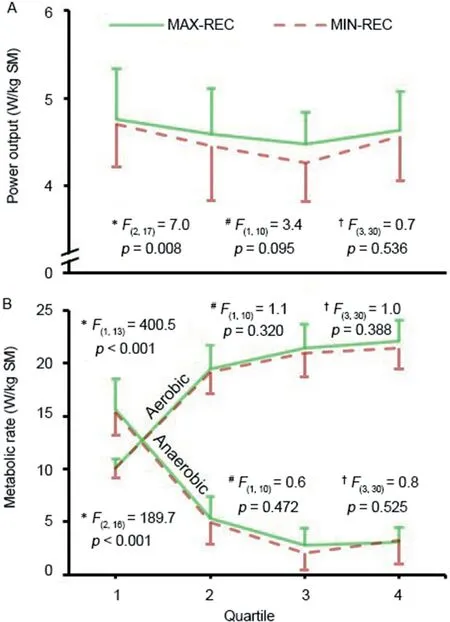
Fig.5. (A)Power output and(B)aerobic and anaerobic metabolic rates during the 4 quartiles of the FSTT after longer (MAX-REC) vs. shorter (MIN-REC)recovery periods (mean § SD). F and p statistics are presented for: *main effect of quartile; #main effect of recovery (i.e., MAX-REC vs. MIN-REC);ymain interaction effect(i.e.,quartile£recovery).FSTT=final sprint time trial;MAX-REC=maximum recovery periods; MIN-REC=minimum recovery periods;SM=system mass.
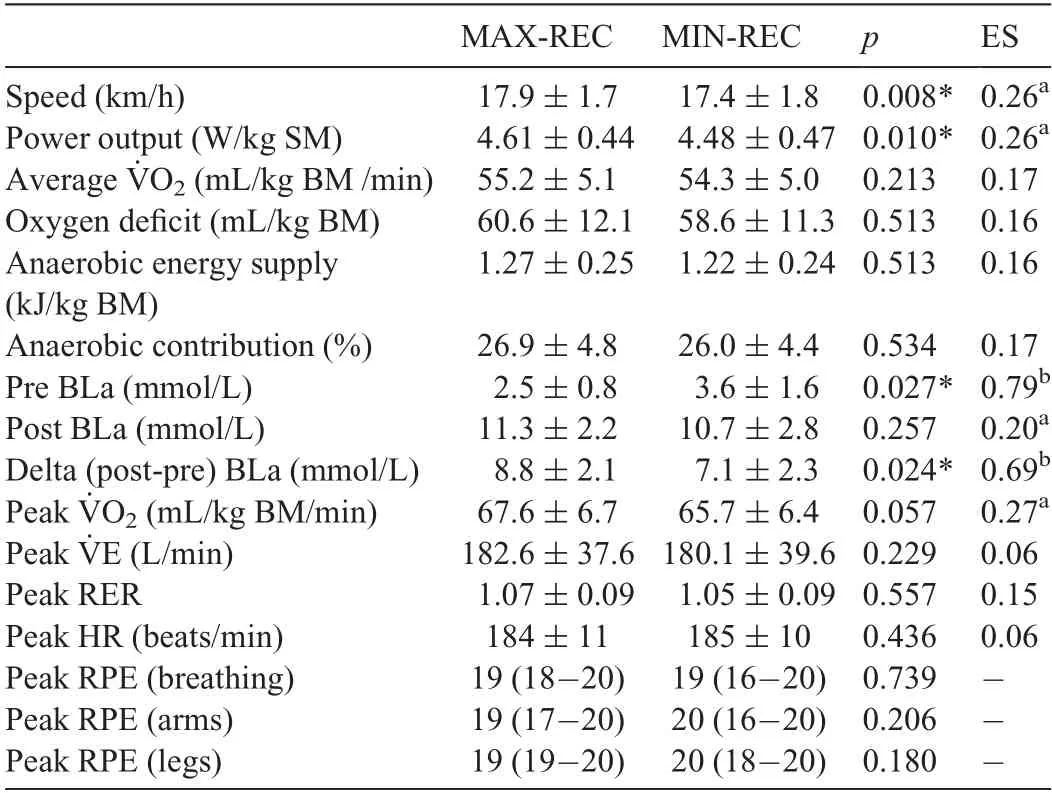
Table 1 Performance and physiological responses (mean § SD) and median (range)RPE during the self-paced FSTT for the trials with longer (MAX-REC) vs.shorter(MIN-REC)recovery periods.
The mean anaerobic contribution during the 3 fixed-speed sprint races in the current study ranged from 22%-24%and from 26%-27% during the FSTT. This is similar to previous research reporting modeled values of 20%-25%.5However,there were no significant differences in aerobic or anaerobic metabolic rates or in anaerobic energy supply during the FSTTbetween the 2 experimental trials.This could be due to individual variation,with some athletes suffering more as a result of the shorter recovery times prescribed between the repeated high-intensity sprints in relation to other athletes. This notion is supported by Vesterinen et al.,6who showed that XC skiers with a higher _VO2peakexperienced less fatigue between the first and the fourth 850-m roller-ski race compared to those with a lower _VO2peak.Furthermore,the metabolic responses and power output were not significantly different across the 4 quartiles of the FSTT, with no significant interaction effects(i.e.,quartile£trial),which implies relatively similar selfselected pacing strategies between the 2 recovery conditions.
There was no significant effect of recovery condition on any of the physiological or perceptual responses to the 3 fixed-speed sprint races,which can be attributed to the standardized exercise intensities. However, there were significant interaction effects for some of the respiratory-derived variables(e.g.,Fig.3A-F),which was unexpected.These differences were small and could possibly be explained by a combination of individual variation and measurement error.During the FSTTthere was a significant effect of recovery condition for pre- and delta BLa, as previously stated. Moreover, there was a small effect of MAX-REC eliciting a higher peak _VO2compared to MIN-REC(ES=0.27,p=0.057), as well as small ES values demonstrating a somewhat higher anaerobic metabolic rate (ES=0.24) and a higher post BLa concentration (ES=0.20) during MAX-REC. These results may combine to explain,at least partially,the improved performance after longer recovery periods.
The current study attempted to control for numerous confounding variables that would affect performance in real-world competition environments, such as weather and snow conditions, ski preparation and selection, differing course profiles,drafting and pacing strategies, etc. Moreover, speed was fixed during the first 3 sprints, which is not the case when athletes participate in sprint XC ski competitions.This level of control was a strength of the current study design, but it limits the application of the findings from the laboratory to the field.Moreover, only the 2 most diverse competition pathways were compared(i.e.,selecting Heat 1 vs.Heat 5 of the QF),and there was no requirement for the participating athletes to balance their recovery-duration choices with choices about whom they would be competing against, which would be an additional factor in real-world XC ski racing. All of these constraints should be considered when interpreting the results of the current study,and future research could attempt to analyze the effect of multiple variables on sprint XC skiing performance.
5. Conclusion
This study has shown that performance within a group of well-trained XC skiers is significantly improved when recovery times between sprint heats are maximized, which in competition conditions would occur when selecting the first QF heat. These novel data may help to inform decision making when XC skiers are faced with selecting a QF heat within a sprint XC ski competition.
Acknowledgments
The authors thank the athletes who took part in the study.This work was supported by a general collaborative grant for winter sport research provided through Mid Sweden University and the €Ostersund municipality (reference number: 2018/1758-500584).
Authors’contributions
KM contributed to the conception and design of the study,the data collection and processing, statistical analyses, interpreting the results,and drafting the manuscript;CVW contributed to the data collection, data processing, and drafting the manuscript; KJW contributed to the conception and design of the study and the data collection; EPA contributed to the conception and design of the study, the data collection and processing, statistical analyses, interpreting the results, and revising the manuscript. All authors have read and approved the final version of the manuscript,and agree with the order of presentation of the authors.
Competing interests
The authors declare that they have no competing interests.
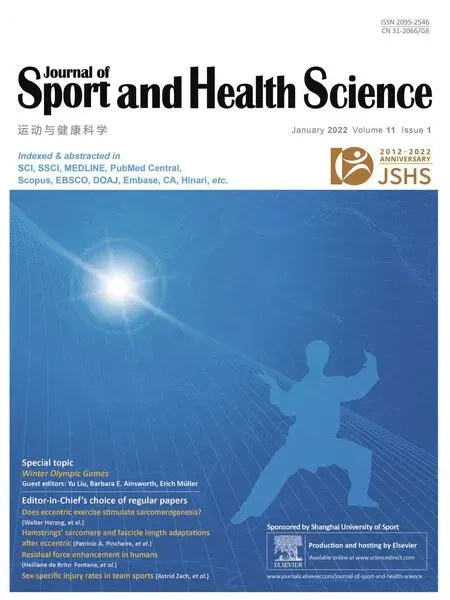 Journal of Sport and Health Science2022年1期
Journal of Sport and Health Science2022年1期
- Journal of Sport and Health Science的其它文章
- Residual force enhancement in human skeletal muscles:A systematic review and meta-analysis
- Sex differences in injury rates in team-sport athletes:A systematic review and meta-regression analysis
- Physical exercises for preventing injuries among adult male football players:A systematic review
- Interference screws vs.suture anchors for isolated medial patellofemoral ligament femoral fixation:A systematic review
- Incidence of injuries in professional snow sports:A systematic review and meta-analysis
- “When you’re down,stay down”:A lesson for all competitive alpine skiers supported by an ACL rupture measured in vivo
